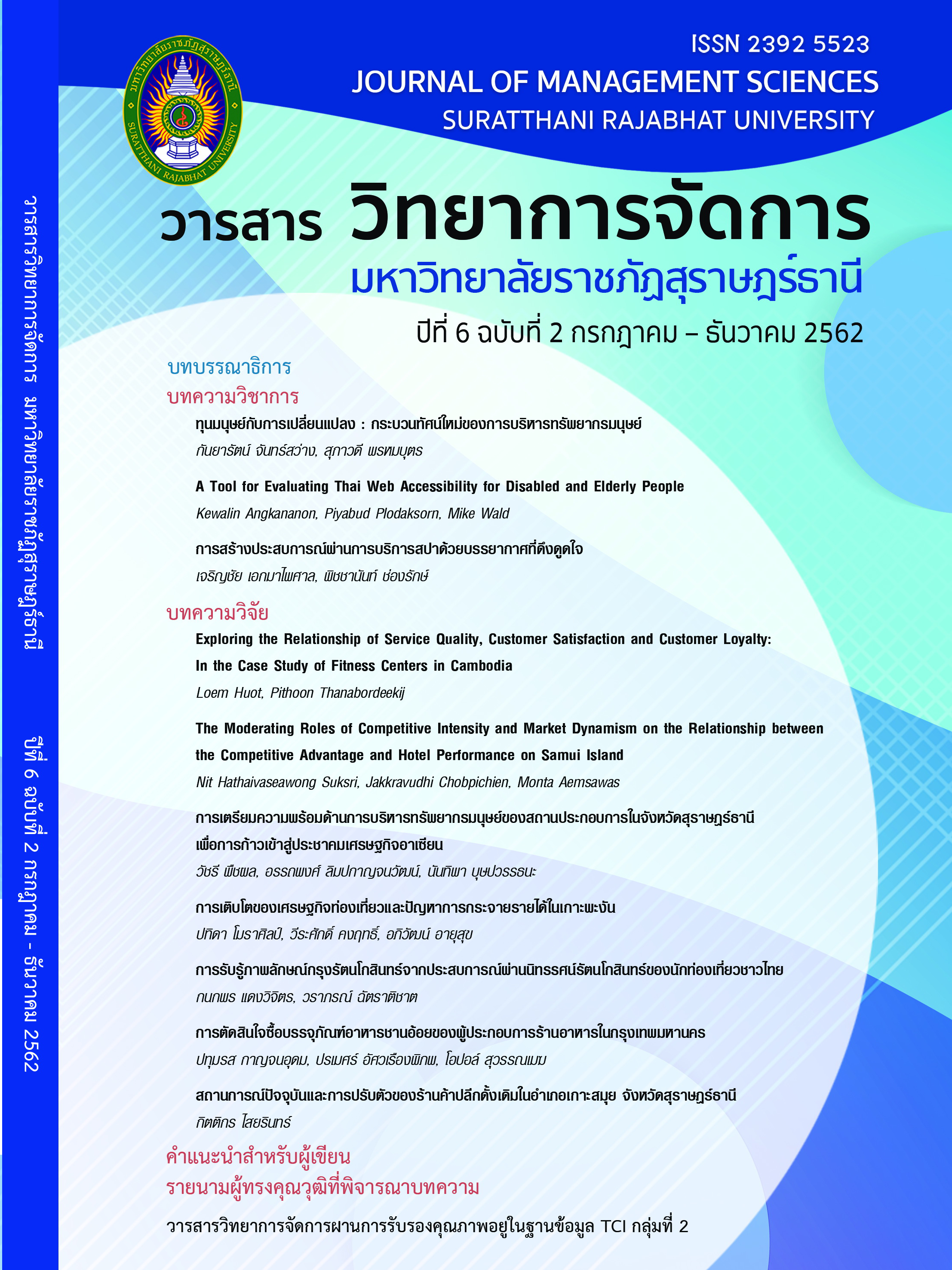The Perception of Rattanakos in Brand Image through Experience from the Rattanakosin Exhibition Hall of Thai Tourists
Main Article Content
Abstract
The objectives of this study on “The Perception of Rattanakosin Brand Image through Experience from the Rattanakosin Exhibition Hall of Thai Tourists” included to study experience of Thai tourists after visiting the Rattanakosin Exhibition Hall; to investigate the perception of Rattanakosin brand image after visiting the Rattanakosin Exhibition Hall; and to explore the relationship between experience and perception of Rattanakosin brand image after visiting the Rattanakosin Exhibition Hall of Thai tourists. This study adopted quantitative research collecting data from 200 Thai tourists aged 15 and above with questionnaire surveys. Schmitt’s (1999) Strategic Experiential Models was adopted as a research framework. It was found that, the average experience level in all five aspects after visiting the Rattanakosin Exhibition Hall was in the highest level. The top rank experience was FEEL experience, followed by SENSE experience and THINK experience. RELATE experience and ACT experience were rated in the high level. The perception of Rattanakosin brand image was in the highest level in all 3 aspects. The top rank brand image was arts, followed by history and culture. The experience after visiting the Rattanakosin Exhibition Hall in route 1 had relationship with Rattanakosin brand perception in the high level at the significant level of .01.
Article Details
References
นิติเทพ ชัยชนะ. (2556). นวัตกรรมบันเทิงศึกษา เทคโนโลยีเพื่อการอนุรักษ์มรดกทางวฒั นธรรม : ศึกษากรณีนิทรรศน์รัตนโกสินทร์. ในคณะสถาปัตยกรรมศาสตร์ มหาวิทยาลัยเชียงใหม่: การประชุมวิชาการระดับชาติมรดกทางวัฒนธรรมที่ถูกลืม: รู้ รักษา สืบสาน. 1 - 13.
นิทรรศน์รัตนโกสินทร์. (ม.ป.ป.). สืบค้นเมื่อ 1 กรกฎาคม 2560,จาก http://www.nitasrattanakosin.com
ปราณี เอี่ยมละออภักดี. (2548).การตลาดประสบการณ์: ประสบการณ์ของลูกค้า. วารสารวิชาการมหาวิทยาลัยหอการค้าไทย. 25(2), 19 - 28.
ปรีชา หงษ์ไกรเลิศ, ปัทมา สูบกำปัง, สติธร ธนานิธิโชติ, นงลักษณ์ อานี และอุมาภรณ์ ศรีสุทธิ์, (2558). สถาบันพระมหากษตัริย์กับสังคมไทย. สืบค้นเมื่อ 1 กรกฎาคม 2560, จาก http://kpi.ac.th/public/knowledge/book/data/491.
พิชชานันท์ สิริภัคพัฒนกุล. (2560). พฤติกรรมการเข้าชม ความพึงพอใจและการใช้ประโยชน์จากการเข้าชมนิทรรศน์รัตนโกสินทร์. วิทยานิพนธ์ปริญญามหาบัณฑิต, มหาวิทยาลัยศรีปทุม.
วราภรณ์ ฉัตราติชาต. (2559, พฤษภาคม). การสร้างประสบการณ์ร่วมกับแบรนด์ผ่านพิพิธภัณฑ์องค์กร:กรณีศึกษาพิพิธภัณฑ์ BMW เมืองมิวนิค สหพันธ์สาธารณรัฐเยอรมนี. การประชุมวิชาการระดับชาติคณะวิทยาการจัดการ มหาวิทยาลัยศิลปากร ครั้งที่ 4 ประจำปี 2559. โรงแรมโนโวเทล หัวหินชะอำ บีช รีสอร์ท แอนด์ สปา, อำเภอชะอำ, จังหวัดเพชรบุรี.
สถาบันพิพิธภัณฑ์การเรียนรู้แห่งชาติ. (2559). ปฏิบัติการพิพิธภัณฑ์ บทเรียนจากคนอื่น. กรุงเทพฯ: เปนไท พับลิชชิ่ง.
สำนักงานสถิติแห่งชาติ. (2560). สำรวจพฤติกรรมการเดินทางท่องเที่ยวของชาวไทย พ.ศ. 2559 (ในรอบปี 2558). กรุงเทพฯ: บริษัท เท็กซ์ แอนด์ เจอร์นัล พับลิเคชั่น จำกัด.
Anholt, S. (2008). Nation branding, place branding, destination branding, country branding, Competitive Identity ... what does it all mean?.Retrieved December 02, 2017. From http://simonanholt.com.
Baloglu, S. and McCleary, K. W. (1999). A model of destination Image Formation. Annals of Tourism Research. Annals of Tourism Research, 26(4): 868 - 897.
Burns, P. and Novelli, M. (2008). Tourism development: growth, myths, and inequalities. UK:Biddles Ltd.
Schmitt, B. (1999). Experiential Marketing: How to Get Customers to Sense, Feel, Think, Act, Relate to Your Company and Brands. New York: The Free Press.


